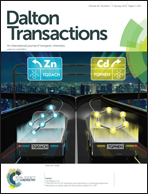A cheap and facile route to synthesize monodisperse magnetic nanocrystals and their application as MRI agents†
Abstract
A facile solution-based thermal decomposition strategy, using very cheap polyisobutylene succimide (PIBSI) and paraffin oil as a surfactant and solvent, respectively, has been developed for the controllable synthesis of magnetic MnFe2O4 and CoFe2O4 nanocrystals (NCs) with high dispersibility, uniform shape, and high yield. By fine-tuning the reaction temperature and growth time, the morphology and size of MnFe2O4 and CoFe2O4 NCs can be simply regulated. It is found that the surfactant PIBSI plays a key role in the final shape of the products due to its long chain with non-polar groups, which can markedly hinder the aggregation of the NCs and thus greatly improve the stability and dispersibility of the products. The results reveal that MnFe2O4 and CoFe2O4 NCs have good biocompatibility and obvious T2 contrast enhancement effects have been achieved with the increase of iron concentration. MnFe2O4 and CoFe2O4 NCs show high longitudinal relaxivity of 165.6 and 65.143 mM−1 S−1 in aqueous solutions due to the positive signal enhancement ability of Fe3+ ions, indicating the highly potential to be used as effective T2 contrast agents for magnetic resonance imaging (MRI).


 Please wait while we load your content...
Please wait while we load your content...